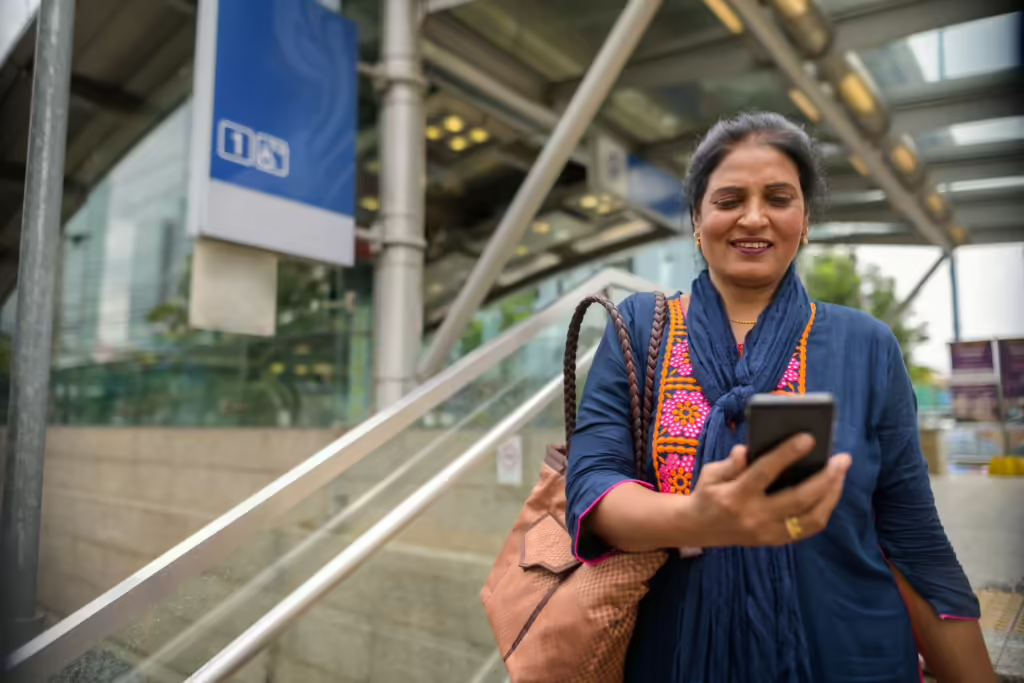Design Thinking for Banking Apps In India: What do Indian Banks need in 2024?

Indian Banking landscape: 100 Billion+ Transactions
Indian banking is undergoing a revolution. As smartphones become ubiquitous, the spotlight is increasingly on mobile banking apps. These apps offer customers convenience, accessibility, and the ability to manage their finances on the go. Yet, with this evolution comes a set of challenges.
India recorded almost 114 billion digital transactions last year, highlighting the rapid adoption of digital banking. However, Indian banks face a unique hurdle: designing mobile banking experiences that are not only functional but also user-centric. Many customers, especially in rural areas, are new to digital banking. Creating an app that is intuitive, accessible, and meets the diverse needs of this demographic is no small feat.
India, with its vast linguistic diversity, presents a unique challenge and opportunity for its banking sector. While over 80% of Indians speak one of the 22 scheduled languages, a significant portion of the population remains unbanked.
According to the Global Findex Database 2021, around 22% of Indian adults lack a bank account. This translates to approximately 190 million unbanked individuals, primarily residing in rural areas. To bridge this gap and enhance financial inclusion, Indian banks must adopt a design-thinking approach. By creating user-friendly, multilingual, and accessible banking solutions, they can empower millions of Indians to participate in the formal financial system, improving their financial well-being and contributing to the nation’s economic growth, which is possible only with Design Thinking.
What is Design Thinking?
A methodology that puts the user at the heart of the design process, design thinking can help banks create apps that truly resonate with their customers. By emphasizing empathy, ideation, and iterative testing, banks can develop solutions that are not only innovative but also highly relevant to their users’ lives. Welcome to a new era of banking, driven by user-centered design principles.
Understanding User Needs and Pain Points in Indian Banking Apps: A Deep Dive
User research and empathy are fundamental in design thinking, particularly when applied to banking apps. By comprehending the real-world experiences and challenges faced by users, banks can craft solutions that genuinely address their needs.
Key User Needs and Pain Points Specific to Indian Banking Customers
Accessibility and Inclusivity
- Digital Divide: According to the Indian government’s latest data, only 46% of the population has internet access, highlighting the digital divide. This disparity is particularly pronounced in rural areas, where banking services are often limited.
- Financial Literacy: A study by the National Council of Applied Economic Research (NCAER) revealed that only 35% of Indians have a basic understanding of financial concepts. This lack of financial literacy can lead to poor decision-making and vulnerability to financial scams.
- Language Barriers: India’s linguistic diversity, with over 720 languages spoken, poses challenges for banks in providing inclusive services. While English is widely understood in urban areas, local languages are essential for reaching a broader customer base.
Language and Cultural Preferences

- Regional Variations: Cultural preferences and banking habits vary significantly across different regions of India. For example, customers in southern India may have different preferences compared to those in northern India.
- Language: While English is widely understood in urban areas, local languages are essential for reaching a broader customer base. Banks must offer apps in multiple languages to cater to diverse customer preferences.
Financial Literacy and Education
- Complex Products: Many banking products, such as loans and investments, are complex and difficult to understand for average customers. This can lead to confusion and mistrust.
- Lack of Financial Education: A large segment of the population lacks basic financial literacy, leading to poor decision-making and vulnerability to financial scams. Banks can play a crucial role in educating customers about financial concepts and best practices.
Security and Privacy Concerns
- Data Breaches: Concerns about data privacy and security have risen in recent years due to increasing cyber threats. Customers are worried about the safety of their personal and financial information.
- Phishing Scams: Customers are vulnerable to phishing attacks and other fraudulent activities. Banks must implement robust security measures and educate customers about safe banking practices.
Seamless Integration with Digital Payments and Other Financial Services
- Unified Experience: Customers expect a seamless experience when interacting with various financial services, such as payments, investments, and insurance. A unified platform can simplify the customer journey and improve satisfaction.
- Interoperability: Banks must ensure compatibility with different digital payment platforms and fintech solutions. This will enable customers to use their preferred payment methods and access a wider range of financial services.
Additional Considerations

- Personalized Experiences: Customers value personalized recommendations and offers tailored to their specific needs. Banks can use data analytics to understand customer preferences and provide relevant recommendations.
- Customer Support: Efficient and responsive customer support is crucial for building trust and loyalty. Banks must invest in customer support channels, such as chatbots and phone support, to ensure quick and effective assistance.
By addressing these user needs and pain points, banks can create more user-centric and effective mobile banking experiences. This approach not only enhances customer satisfaction but also fosters long-term loyalty and trust.
Design Thinking Process for Indian Banking Apps
Define the Problem
The first step in the design thinking process is to define the problem. This involves identifying specific challenges and opportunities within the Indian banking context. Some key areas to consider include:
- Accessibility: How can we make banking services more accessible to underserved populations, such as those in rural areas or with disabilities?
- Financial Literacy: How can we help customers better understand financial concepts and make informed decisions?
- Security: How can we protect customers from fraud and data breaches while ensuring a seamless user experience?
- Personalization: How can we tailor banking services to individual customer needs and preferences?
- Integration: How can we seamlessly integrate banking services with other financial products and services, such as payments and investments?
Example: A bank might identify a problem with low digital adoption among rural customers. They could conduct research to understand the barriers to adoption, such as lack of internet access or financial literacy.
Ideate

Once the problem has been defined, the next step is to ideate potential solutions. This involves brainstorming and divergent thinking to generate a wide range of ideas. Some techniques that can be used include:
- Brainstorming: A group activity where participants generate ideas without judgment.
- Mind mapping: A visual tool for organizing ideas and identifying connections.
- SCAMPER: A problem-solving technique that involves substituting, combining, adapting, modifying, putting to another use, eliminating, and reversing.
Example: A bank might brainstorm ideas for improving digital adoption among rural customers. Some ideas could include offering mobile banking services with limited data requirements, providing financial literacy training, and partnering with local organizations to increase awareness of digital banking.
Prototype
The next step is to prototype potential solutions. This involves creating low-fidelity models or mockups of the proposed designs. Prototypes can be used to test the feasibility and usability of ideas before investing significant resources in development.
Example: A bank might create a low-fidelity prototype of a mobile banking app that includes features such as account balance checks, bill payments, and money transfers. The prototype could be tested with potential users to gather feedback on the design and functionality.
Test
Once prototypes have been created, they can be tested with users. This involves gathering feedback on the usability and effectiveness of the designs. Some methods for testing include:
- Usability testing: Observing users as they interact with the prototype and identifying any pain points or difficulties.
- A/B testing: Comparing two or more versions of a design to determine which one performs better.
Example: A bank might conduct usability testing with rural customers to evaluate the ease of use of their mobile banking app prototype. They could also conduct A/B testing to compare different versions of the app’s interface.
Iterate
Based on the feedback gathered during testing, the design can be iterated upon. This involves refining the design and making improvements based on user insights. The iterative process can continue until the final product meets the desired level of quality and usability.
Example: A bank might make changes to their mobile banking app based on feedback from usability testing. For example, they might simplify the user interface or add features that were requested by users.
Key Design Principles for Indian Banking Apps: A Deeper Dive

- Clear and concise language: Use simple, everyday language that is easily understandable by a wide range of users, including those with limited financial literacy. Avoid jargon and technical terms.
- Minimalist design: Focus on essential features and information, avoiding clutter and distractions. A clean and uncluttered interface can reduce confusion and improve usability.
- Intuitive navigation: Design a navigation structure that is easy to follow and understand. Use clear labels, consistent icons, and a logical flow to guide users through the app.
Example: A banking app might use simple icons and labels for features like “Home,” “Accounts,” and “Payments.” The app’s layout should be consistent and easy to navigate, even for first-time users.
Personalization
- Customized recommendations: Offer personalized recommendations based on user behavior, preferences, and financial goals. This can help customers discover relevant products and services and improve their overall banking experience.
- Goal-setting tools: Help users set financial goals and track their progress. This can motivate users to save, invest, or manage their finances more effectively.
- Personalized notifications: Send relevant notifications based on user activity, such as upcoming bill payments, investment opportunities, or account alerts. This can help users stay informed and take timely action.
Example: A banking app might recommend investment products based on a user’s risk tolerance and financial goals. The app could also send notifications about upcoming bill payments or investment opportunities.
Accessibility
- Compliance with accessibility standards: Ensure the app complies with accessibility standards like WCAG (Web Content Accessibility Guidelines) to make it usable for people with disabilities.
- High contrast: Use high-contrast colors and fonts to make the app easier to read for users with visual impairments.
- Voiceover and screen reader support: Enable voiceover and screen reader features for users with visual or hearing impairments.
- Keyboard navigation: Allow users to navigate the app using a keyboard, which is essential for users with motor disabilities.
Example: A banking app might use a high-contrast color scheme and provide options for adjusting font size and color. The app could also include voiceover features to guide users through the interface.
Security and Privacy
- Strong encryption: Use strong encryption to protect user data from unauthorized access. This is particularly important in India, where concerns about data security and privacy have increased in recent years.
- Multi-factor authentication: Require multiple forms of authentication, such as passwords, biometrics, or security codes, to enhance security and prevent unauthorized access.
- Regular security updates: Keep the app up-to-date with the latest security patches and updates to address emerging threats.
- Transparent security practices: Communicate security practices clearly to build trust with customers.
Example: A banking app might use 256-bit encryption to protect user data and require multi-factor authentication for login. The app should also regularly update its security features to address emerging threats.
Cultural Sensitivity
- Localized content: Use culturally relevant language, images, and metaphors to resonate with Indian customers.
- Consider cultural preferences: Be mindful of cultural preferences related to colors, symbols, and design elements. For example, certain colors or symbols may have different meanings in Indian culture.
- Respect religious and cultural sensitivities: Avoid using imagery or content that could be offensive to certain cultural or religious groups.
Example: A banking app might use culturally relevant imagery in its marketing materials. The app should also avoid using symbols or language that could be offensive to certain religious or cultural groups.
By adhering to these key design principles, Indian banks can create banking apps that are not only user-friendly but also secure, accessible, and culturally sensitive. This will help to improve customer satisfaction, loyalty, and overall business success.
Case Studies of Successful Indian Banking Apps
Paytm
- Design Strategy: Paytm has focused on a simple and intuitive user interface, making it easy for users to navigate and complete transactions. The app has also incorporated gamification elements, such as rewards and badges, to make the experience more engaging.
- Features: Key features include mobile payments, bill payments, recharges, travel bookings, and financial services.
- Success: Paytm has become one of the most popular digital wallets in India, with over 330 million monthly active users as of 2023. The app’s success can be attributed to its user-friendly interface, wide range of features, and strong marketing campaigns.
PhonePe
- Design Strategy: PhonePe has prioritized a clean and minimalist design, making it easy for users to find the features they need. The app has also focused on integrating with UPI (Unified Payments Interface), making it a convenient option for peer-to-peer payments.
- Features: Key features include mobile payments, bill payments, recharges, and investment products.
- Success: PhonePe has experienced rapid growth in recent years, becoming one of the leading digital payment platforms in India. The app’s success can be attributed to its focus on simplicity, integration with UPI, and aggressive marketing efforts. As of 2023, PhonePe had over 350 million monthly active users.
HDFC Bank Mobile Banking App
- Design Strategy: HDFC Bank has invested heavily in redesigning its mobile banking app to improve user experience. The app now features a more intuitive interface, personalized recommendations, and biometric authentication.
- Features: Key features include account management, bill payments, transfers, loans, and investments.
- Success: HDFC Bank’s mobile banking app has been recognized for its innovative features and user-friendly design. The app has helped to drive digital adoption among HDFC Bank customers. According to a report by Forrester, HDFC Bank’s mobile app was ranked among the top five banking apps in India in 2023.
Kotak Mahindra Bank Mobile Banking App
- Design Strategy: Kotak Mahindra Bank has focused on providing a seamless and personalized experience for its customers. The app features a chatbot that can assist users with queries and transactions.
- Features: Key features include account management, bill payments, transfers, loans, and investments.
- Success: Kotak Mahindra Bank’s mobile banking app has been praised for its innovative features and customer-centric approach. The app has helped to improve customer satisfaction and loyalty. According to a survey by KPMG, Kotak Mahindra Bank’s mobile app was rated among the top three banking apps in India in 2023.
BHIM UPI
BHIM UPI is a government-backed initiative that aims to promote digital payments in India. It is a Unified Payments Interface (UPI) app developed by the National Payments Corporation of India (NPCI). BHIM UPI has been instrumental in driving the adoption of digital payments in India, particularly among small businesses and individuals in rural areas.
- Design Strategy: BHIM UPI has a simple and intuitive user interface, making it easy for users to send and receive money. The app is designed to work seamlessly with various bank accounts and UPI-enabled apps.
- Features: Key features include peer-to-peer payments, bill payments, and QR code scanning.
- Success: BHIM UPI has been a major success in India, with over 200 million monthly active users as of 2023. The app’s success can be attributed to its government backing, widespread adoption, and focus on simplicity. BHIM UPI has played a crucial role in promoting financial inclusion and reducing the reliance on cash.
Key factors contributing to BHIM UPI’s success
- Government backing: As a government-backed initiative, BHIM UPI has received significant support and promotion from the Indian government.
- Interoperability: BHIM UPI works seamlessly with various banks and UPI-enabled apps, making it a convenient option for users.
- Simplicity: The app has a simple and intuitive user interface that is easy to understand and use, even for first-time users.
- Security: BHIM UPI uses robust security measures to protect user data and prevent fraud.
- Awareness campaigns: The government and NPCI have conducted extensive awareness campaigns to promote the use of BHIM UPI.
Future Trends and Opportunities in Indian Banking App Design
Emerging Technologies and Trends
- Artificial Intelligence (AI): AI can revolutionize the banking industry by enabling hyper-personalization, fraud detection, and intelligent customer support.
- Personalization: AI can analyze customer data to provide tailored recommendations, offers, and insights.
- Fraud detection: AI algorithms can detect and prevent fraudulent transactions more effectively than traditional methods.
- Intelligent customer support: AI-powered chatbots can provide 24/7 customer support and answer common queries.
- Biometrics: Biometric authentication, such as facial recognition, fingerprint scanning, and voice recognition, can enhance security and provide a more convenient user experience.
- Enhanced security: Biometrics can make it more difficult for unauthorized individuals to access accounts.
- Personalized experiences: Biometrics can be used to personalize the app experience, recognizing and greeting users by name.
- Blockchain: Blockchain technology can streamline processes, improve security, and enable new financial products and services.
- Supply chain finance: Blockchain can be used to track the movement of goods and optimize supply chain financing.
- Trade finance: Blockchain can simplify trade finance processes by providing a transparent and secure platform for transactions.
- New financial products: Blockchain can enable new financial products, such as tokenized assets and decentralized finance (DeFi) applications.
- Internet of Things (IoT): IoT devices can be integrated with banking apps to provide personalized financial insights and enable contactless payments.
- Personalized insights: IoT devices can collect data on user spending habits and provide personalized financial recommendations.
- Contactless payments: IoT devices, such as smartwatches and wearables, can be used for contactless payments.
- Augmented Reality (AR) and Virtual Reality (VR): AR and VR can be used to create immersive and engaging banking experiences.
- Virtual branches: Banks can offer virtual branches that allow customers to interact with bank representatives in a virtual environment.
- Interactive tutorials: AR and VR can be used to create interactive tutorials that help customers understand complex financial products.
Opportunities for Indian Banks
- Hyper-personalization: Use AI and data analytics to provide highly personalized banking experiences that meet the unique needs of each customer.
- Voice-enabled banking: Enable customers to interact with banking apps using voice commands, making it easier for users to access their accounts and perform transactions.
- Blockchain-based solutions: Explore blockchain-based solutions for supply chain finance, trade finance, and other areas to gain a competitive advantage.
- IoT integration: Integrate banking apps with IoT devices to provide personalized financial insights and enable contactless payments.
- Gamification: Use gamification elements to make banking more engaging and rewarding for customers, such as rewards programs, challenges, and leaderboards.
By embracing these emerging technologies and trends, Indian banks can create innovative and customer-centric banking apps that meet the evolving needs of the market. This will help banks to differentiate themselves from competitors, improve customer satisfaction, and drive growth.


